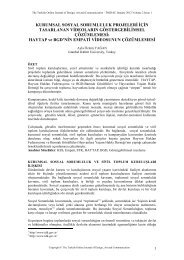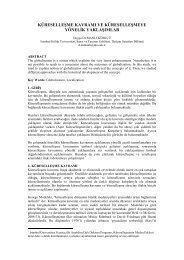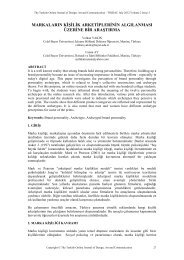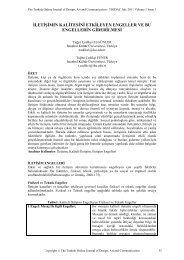aprıl 2012 - tojdac.org
aprıl 2012 - tojdac.org
aprıl 2012 - tojdac.org
Create successful ePaper yourself
Turn your PDF publications into a flip-book with our unique Google optimized e-Paper software.
The Turkish Online Journal of Design, Art and Communication - TOJDAC April <strong>2012</strong> Volume 2 Issue 2<br />
propagates through a section of the population, teaching and changing and influencing<br />
everyone it touches.” As consumers are not obsessed with products but with ideas, it is<br />
imperative that the viral strategy is based on an inherently brilliant idea in order to reach its<br />
target audience. “Viral marketing is an ideavirus, but not all ideaviruses are viral marketing.<br />
Viral marketing is an ideavirus in which the medium of the virus IS the product.” [4]<br />
Rosen’s concept of “buzz” that is defined as “the sum of all comments about a certain product<br />
that are exchanged among people at any given time” is similar to the “ideavirus.” Rosen<br />
argues that people share a message about something that relates to their lives therefore the<br />
challenge for viral marketing is to stimulate this pass-along process artificially. [4] Gladwell<br />
shows that ideas, products and even behavior patterns can spread just as viruses do.<br />
Contagiousness and epidemics are the central ideas that explain the dynamics of viral<br />
phenomena. [8] Contagiousness is also related with the idea of “memes.” A meme is<br />
explained as a “unit of cultural transmission, or a unit of imitation. …Examples of memes are<br />
tune, ideas, catch-phrases, clothes, fashion, ways of making pots or building arches. …memes<br />
propagate themselves in the meme pool by leaping from brain to brain via a process which, in<br />
the broad sense, can be called imitation.” [6] Since consumers’ minds are cluttered from<br />
information overload, the success of the message relies on its infectiousness. Creativity and<br />
uniqueness of the message clearly create the basis of a potent meme. Viral advertising differs<br />
from viral marketing in the sense that the former refers to a comprehensive marketing strategy<br />
while viral advertising is the online advertising technique. Thus it is important to investigate<br />
the similarities and differences between traditional and viral advertising.<br />
Advertising is traditionally defined as “paid persuasive communication that uses non-personal<br />
mass media to reach broad audiences to connect an identified sponsor with a target audience”<br />
[7]. When advertising becomes viral, it changes some of its traditional properties. While<br />
traditional advertising is non-personal, viral advertising is highly personal. The content of<br />
viral advertising is intended to be shared among trusted sources such as friends and family. In<br />
other words, viral advertising aims for personal recommendations. The sponsors in viral<br />
advertising, although usually not as overt as traditional advertising, can be identified.<br />
Through the provocative content of the sponsor, viral advertising’s aim is to associate positive<br />
feelings to the product or brand. Provocative content may be achieved by the use of humor as<br />
well as emotional appeals so that the consumer is inclined to pass it along to other users. Viral<br />
advertising might use elements of mass communication, however its main medium is the<br />
Internet. Thus, viral advertising can be defined as “unpaid peer-to-peer communication of<br />
provocative content originating from an identified sponsor using the Internet to persuade or<br />
influence an audience to pass along the content to others.” [1]<br />
Focusing on eWOM, early studies that focused on forwarding email concluded that<br />
advertisers mainly concentrate on “desires for fun, entertainment and social connections” [9].<br />
Most viral advertising follows this recommendation. Although an inspiring tool, viral<br />
marketing is open to overuse as a concept to push products that are not inherently viral. Some<br />
marketers are inclined to use a new concept ad nauseam boring the public with the same tools<br />
of reaching the consumers. Yet, consumers are able to use their judgment on forwarding<br />
content [5].<br />
2. STRATEGIES FOR SUCCESSFUL VIRAL ADVERTISING<br />
2.1 Raw, provocative content<br />
Viral advertising depends heavily on provocative content to “motivate unpaid peer-to-peer<br />
communication of persuasive messages from identified sponsors” more than traditional<br />
advertising. Although emotional content has been the key influencer in captivating traditional<br />
advertising audiences, with viral advertising, raw content tends to be a more important<br />
element for actual dissemination. [1] Viral advertising works better when the content is<br />
surprising, unique, challenging or inspiring.<br />
Copyright © The Turkish Online Journal of Design, Art and Communication 40









